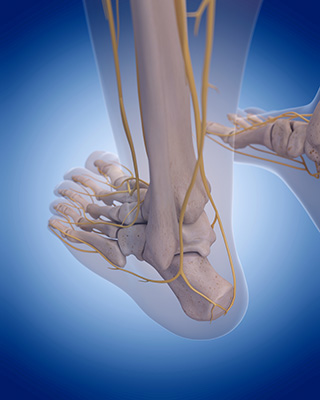What is the Tarsal Tunnel?
The tarsal tunnel is an area on the inside of the ankle where your nerves, veins, and arteries travel. These structures are held in place by a thick fibrous structure called a retinaculum. At times, your nerve can becomes irritated and cause tarsal tunnel syndrome. This is similar to carpal tunnel Syndrome of the wrist, and can be produced by stretching or compression of the nerve within the tunnel.
Causes:
 There are many possible causes. Included below are a few of the most common:
There are many possible causes. Included below are a few of the most common:
• Flat feet and fallen arches
• Cysts, tendonitis, varicose veins, bone spurs
• Systemic conditions like diabetes
Symptoms
Patients with tarsal tunnel syndrome experience one or more of the following symptoms:
• Burning or tingling and electrical type pain
• Numb toes or numbness around the ankle
• Pain, especially shooting pain or pins and needles
The symptoms are usually around the inside of the ankle, or the tibial bone area. However, some people will experience pain into their toes or top of the foot or calf. Symptoms may be brought on suddenly or may get worse with time. It is very important to seek help from your foot and ankle doctor to help minimize long-term complications like permanent numbness or loss of function.
Diagnosis
The foot and ankle doctor will examine your foot and ankle and pertinent medical issues. Often times one can strike the nerve and recreate the sensations. Further medical imaging or testing can be ordered, such as nerve conduction studies or an MRI.
Non-surgical Treatment
A variety of treatment options, often used in combination, are available to treat tarsal tunnel syndrome. These include:
• Rest. Staying off the foot prevents further injury and encourages healing.
• Ice. Apply an ice pack to the affected area, placing a thin towel between the ice and the skin. Use ice for 20 minutes and then wait at least 40 minutes before icing again.
• Oral medications. Nonsteroidal anti-inflammatory drugs (NSAIDs), such as ibuprofen, help reduce the pain and inflammation.
• Immobilization. Restricting movement of the foot by wearing a cast is sometimes necessary to enable the nerve and surrounding tissue to heal.
• Physical therapy. Ultrasound therapy, exercises, and other physical therapy modalities may be prescribed to reduce symptoms.
• Injection therapy. Injections of a local anesthetic provide pain relief, and an injected corticosteroid may be useful in treating the inflammation.
• Custom orthotic devices. Custom shoe inserts may be prescribed to help maintain the arch and limit excessive motion that can cause compression of the nerve.
• Bracing. Patients can find relief with specific braces.
When is Surgery Needed?
Sometimes surgery is the best option for treating tarsal tunnel syndrome. The foot and ankle surgeon will determine if surgery is necessary and will select the appropriate procedure or procedures based on the cause of the condition.






